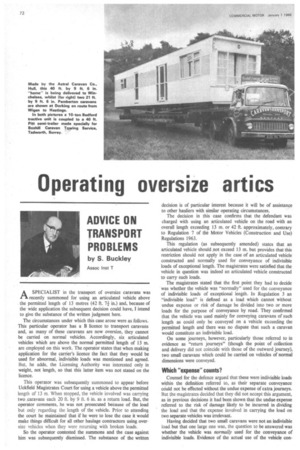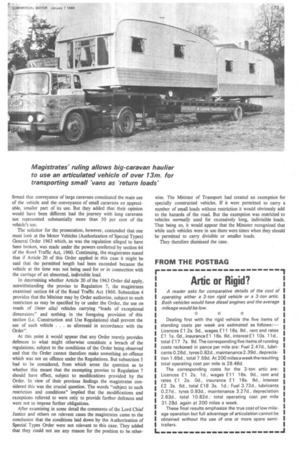Operating oversize artics
Page 74

Page 75

If you've noticed an error in this article please click here to report it so we can fix it.
ADVICE ON TRANSPORT PROBLEMS
by S. Buckley
Assoc I nst T
ASPECIALIST in the transport of oversize caravans was recently summoned for using an articulated vehicle above the permitted length of 13 metres (42 ft. 7in.) and, because of the wide application the subsequent decision could have, [intend to give the substance of the written judgment here.
The circumstances under which this case arose were as follows. This particular operator has a B licence to transport caravans and, as many of these caravans are now oversize, they cannot be carried on normal vehicles. Accordingly, six articulated vehicles which are above the normal permitted length of 13 m. are employed on this work. The operator states that when making application for the carrier's licence the fact that they would be used for abnormal, indivisible loads was mentioned and agreed. But, he adds, the Licensing Authority was interested only in weight, not length, so that this latter item was not stated on the licence.
This operator was subsequently summoned to appear before Uckfield Magistrates Court for using a vehicle above the permitted length of 13 m. When stopped, the vehicle involved was carrying two caravans each 20 ft. by 9 ft. 6 in. as a return load. But, the operator comments, he was not prosecuted because of the load but only regarding the length of the vehicle. Prior to attending the court he maintained that if he were to lose the case it would make things difficult for all other haulage contractors using oversize vehicles when they were reiurning with broken loads.
So the operator contested the summons and the case against him was subsequently dismissed. The substance of the written decision is of particular interest because it will be of assistance to other hauliers with similar operating circumstances.
The decision in this case confirms that the defendant was charged with using an articulated vehicle on the road with an overall length exceeding 13 m. or 42 ft. approximately, contrary to Regulation 7 of the Motor Vehicles (Construction and Use) Regulations 1963.
This regulation (as subsequently amended) states that an articulated vehicle should not exceed 13 m. but provides that this restriction should not apply in the case of an articulated vehicle constructed and normally used for conveyance of indivisible loads of exceptional length. The magistrates were satisfied that the vehicle in question was indeed an articulated vehicle constructed to carry such loads.
The magistrates stated that the first point they had to decide was whether the vehicle was "normally" used for the conveyance of indivisible loads of exceptional length. In Regulation 3 an "indivisible load" is defined as a load which cannot without undue expense or risk of damage be divided into two or more loads for the purpose of conveyance by road. They confirmed that the vehicle was used mainly for conveying caravans of such length as could only be conveyed on a vehicle exceeding the permitted length and there was no dispute that such a caravan would constitute an indivisible load.
On some journeys, however, particularly those referred to in evidence as "return journeys" (though the point of collection and delivery did not coincide with those of the outward journey), two small caravans which could be carried on vehicles of normal dimensions were conveyed.
Which "expense" counts?
Counsel for the defence argued that these were indivisible loads within the definition referred to, as their separate conveyance cOuld not be effected without the undue expense of extra journeys. But the magistrates decided that they did not accept this argument, as in previous decisions it had been shown that the undue expense referred to the risk of damage likely to be incurred in dividing the load and that the expense involved in carrying the load on two separate vehicles was irrelevant.
Having decided that two small caravans were not an indivisible load but that one large one was, the question to be answered was whether the vehicle was normally used for the conveyance of indivisible loads. Evidence of the actual use of the vehicle con
firmed that conveyance of large caravans constituted the main use of the vehicle and the conveyance of small caravans an appreciable, smaller part of its use. But they added that their opinion would have been different had the journey with long caravans not represented substantially more than 50 per cent of the vehicle's use.
The solicitor for the prosecution, however, contended that one must look at the Motor Vehicles (Authorization of Special Types) General Order 1963 which, as was the regulation alleged to have been broken, was made under the powers conferred by section 64 of the Road Traffic Act, 1960. Continuing, the magistrates stated that if Article 20 of this Order applied in this case it might be said that the permitted length had been exceeded because the vehicle at the time was not being used for or in connection with the carriage of an abnormal, indivisible load.
In determining whether Article 20 of the 1963 Order did apply, notwithstanding the proviso to Regulation 7, the magistrates examined section 64 of the Road Traffic Act 1960. Subsection 4 provides that the Minister may by Order authorize, subject to such restriction as may be specified by or under the Order, the use on roads of (inter alio) vehicles carrying "loads of exceptional dimensions" and nothing. in the foregoing provision of this section (i.e. Construction and Use Regulations) shall prevent the use of such vehicle . . . as aforesaid in accordance with the Order".
At this point it would appear that any Order merely provides defences to what might otherwise constitute a breach of the regulations, subject to the conditions of the Order being observed and that the Order cannot therefore make something an offence which was not an offence under the Regulations. But subsection 5 had to be considered, from which arose the question as to whether this meant that the exempting proviso to Regulation 7 should have effect, subject to modifications provided by the Order. In view of their previous findings the magistrates considered this was the crucial question. The words "subject to such restriction and conditions" implied that the modifications and exceptions referred to were only to provide further defences and were not to impose further obligations.
After examining in some detail the comments of the Lord Chief Justice and others on relevant cases the magistrates came to the conclusion that the conditions laid down by the Authorization of Special Types Order were not relevant to this case. They added that they could not see any reason for the position to be other wise. The Minister of Transport had created an exemption for specially constructed vehicles. If it were permitted to carry a number of small loads without restriction it would obviously add to the hazards of the road. But the exemption was restricted to vehicles normally used for excessively long, indivisible loads. That being so, it would appear that the Minister recognized that while such vehicles were in use there were times when they should be permitted to carry divisible or smaller loads.
They therefore dismissed the case.
FROM THE POSTBAG




















































































































